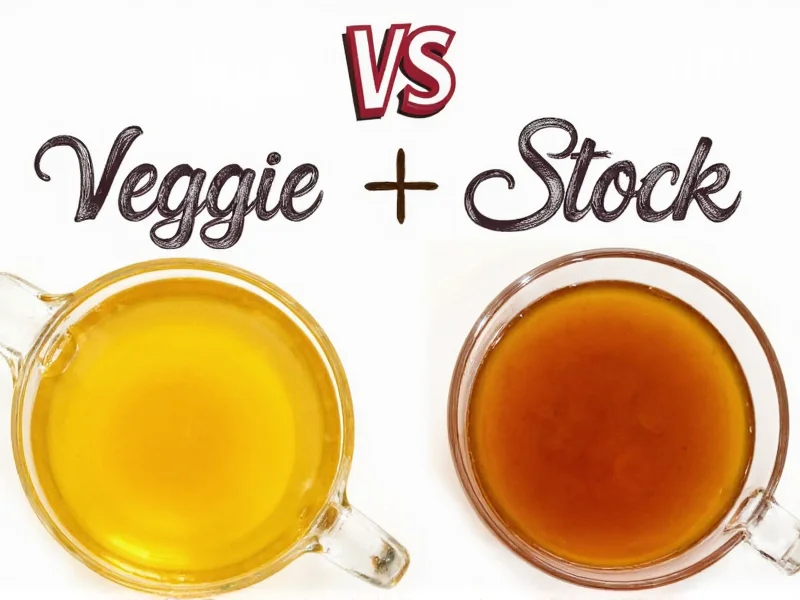Understanding the distinction between vegetable broth and stock transforms your cooking results. Many chefs and home cooks use these terms interchangeably, but professional culinary practice recognizes important differences that affect flavor development, recipe outcomes, and dietary considerations. Getting this right matters whether you're making a delicate consommé or hearty stew.
What Exactly Is Vegetable Broth?
Vegetable broth represents a ready-to-consume liquid made by simmering vegetables, herbs, and seasonings—typically including salt—for 45-90 minutes. Commercial producers often enhance broth with yeast extract, tomato paste, or additional flavorings to create a more robust profile. The addition of salt during preparation makes broth immediately palatable but limits its versatility in recipes where sodium control matters.
When examining vegetable broth preparation methods, notice how home cooks often add mirepoix (celery, carrots, onions), garlic, herbs like thyme and bay leaves, plus salt early in the cooking process. This seasoning creates a finished product that can be sipped as-is—a quality that defines true broth. Many store-bought vegetable broths contain 700-800mg of sodium per cup, making them problematic for low-sodium diets.
Defining Vegetable Stock: The Culinary Foundation
Vegetable stock serves as an unseasoned cooking foundation, simmered for 2-4 hours to extract maximum flavor without added salt. Professional kitchens rely on stock as a neutral base that won't overpower delicate dishes. Unlike broth, stock contains no added seasonings, allowing chefs precise control over final dish seasoning.
The vegetable stock cooking process focuses on extracting gelatinous compounds and deep flavors through extended simmering. While meat-based stocks benefit from bones, vegetable stock relies on mushrooms, tomatoes, and dark leafy greens for umami depth. Proper vegetable stock should have a rich, concentrated flavor that intensifies when reduced—qualities compromised when salt enters the equation prematurely.
| Characteristic | Vegetable Broth | Vegetable Stock |
|---|---|---|
| Seasoning | Contains salt and herbs during cooking | Unseasoned (no salt added) |
| Cooking Time | 45-90 minutes | 2-4 hours |
| Flavor Profile | Bright, immediate flavor | Concentrated, neutral base |
| Sodium Content | High (700-800mg/cup) | Negligible |
| Primary Use | Ready-to-drink, light soups | Cooking foundation for sauces, stews |
| Shelf Life | Shorter (due to seasonings) | Longer (freezes better) |
When to Use Each: Practical Cooking Applications
Choosing between vegetable broth versus stock for soup making depends on your recipe's requirements. For quick weeknight vegetable soup where you'll add other seasonings, unsalted stock gives better control. When reviving leftovers or creating a simple miso soup, ready-seasoned broth saves time.
Chefs consistently recommend stock for risotto, grain pilafs, and braising liquids where the cooking liquid becomes part of the final dish. The absence of salt prevents over-seasoning as liquids reduce. Broth shines in applications like vegetable broth for cooking grains when you want immediate flavor infusion without additional seasoning.
Creating Perfect Homemade Versions
Mastering how to make vegetable stock from scraps reduces food waste while creating superior flavor. Save clean vegetable trimmings (onion skins, carrot tops, celery leaves, mushroom stems) in a freezer bag until you have 4-5 cups. Add to cold water with a splash of vinegar (helps extract minerals), then simmer covered for 3 hours. Strain through cheesecloth for crystal-clear results.
For low sodium vegetable broth recipe options, simmer vegetables with herbs for 45 minutes, then add salt only to taste at the end. This approach gives complete sodium control—crucial for those managing hypertension. Include umami boosters like dried shiitake mushrooms or a Parmesan rind (if not strictly vegetarian) for depth without salt.
Substitution Guidelines and Common Mistakes
Understanding can I substitute vegetable broth for stock scenarios prevents culinary disasters. When substituting broth for stock, reduce added salt elsewhere in the recipe by 25-50%. Never substitute store-bought broth for stock in reductions—it will become unpleasantly salty.
A frequent error involves vegetable stock vs broth for gravy preparation. Stock's neutral profile allows better flavor layering in pan sauces and gravies. Using seasoned broth often creates one-dimensional, overly salty results. For cream-based sauces, always start with stock, then adjust seasoning at the end.
Addressing Common Misconceptions
Many believe is vegetable stock just unseasoned broth—technically yes, but the distinction runs deeper. Stock's longer cooking time extracts different compounds, creating a more viscous liquid with better mouthfeel. The absence of early salt allows vegetables to release flavors more completely during extended simmering.
Another myth suggests vegetable broth has more nutrients than stock. Both contain similar nutritional profiles since vegetables release comparable nutrients regardless of cooking time. Any differences come from added ingredients, not the fundamental preparation method.











 浙公网安备
33010002000092号
浙公网安备
33010002000092号 浙B2-20120091-4
浙B2-20120091-4